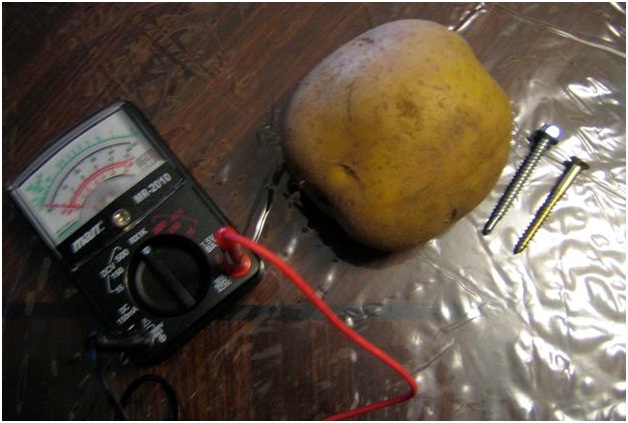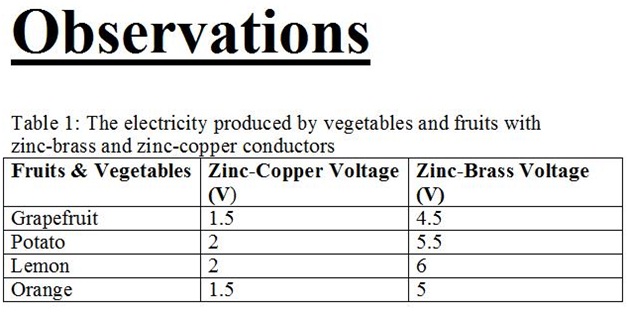





Published on Feb 13, 2025
The objective: To find out which fruit or vegetable has the most stored electricity.
The world is dependant on electricity. It is what powers our lights, radios, TVs and cell phones,but how does it do it? From a scientific point of view, electricity is energy formed by the flow of electrons. Through learning about electricity, circuits, and currents, one can explore how vegetables store energy to create electricity.
Electricity is something that powers the world we live in which is why it is so important to learn more about how it works, the electrical currents it creates and how to measure it. Electricity is essentially a part of everything because everything is made up of atoms. The simplest way to define electricity would be to say that it is the energy formed by the flow of electrons. Therefore, all materials have electrons and potential energy. Potential energy is stored energy. In order for potential energy to move through a conductor, a force is needed. A conductor can be material such as copper and most metals. What makes it unique is that it allows electrons to flow through it.
Luigi Galvani and Alessandro Volta made this discovery in the late 1700s. They discovered conductivity when they did an experiment that tested if an iron hooked attached to a frog touching a copper wire would move the frog. They concluded that the frog’s muscles served as a conductor allowing electricity to pass through. A conductive solution can use any electrolyte such as an acid, base or salt solution. Several vegetables and fruits contain juices that are rich in ions and are acidic, and can therefore behave as good conductors. A second type of electricity is known as static electricity.
Static electricity has the ability to be very powerful like lightning and less powerful like amber being rubbed against wool. It has a special force that allows the amber to attract bits of materials. A Greek philosopher, Thales, founded this discovery. Thales is famous for proving his claim that lightning was electrical by doing a well-known key and kite test. Both of these types of electricity have big uses in our world and now lets see how they can be applied.
How does a fruit or vegetable battery work? Just like a normal circuit, a circuit powered by fruits or vegetables needs energy and conductors. When using a fruit as a battery you could use copper, brass or zinc as active metals. The metals react with the acid in the fruit or vegetable because the juice is rich in positively charged ions. The two nails act as positive and negative poles for the battery. T
he electrons travel from the positive pole to the negative pole, generating electricity. Like any other battery, a potato can only last for so long. Eventually, the electrodes undergo chemical reactions that block the flow of electricity, the result being the battery stops working. What typically happens is the production of hydrogen at the copper electrode and the zinc electrode searches for deposits of oxides that act as a blockage between the metal and the electrolyte. This process is known as electrodes being polarized. To get a longer lasting life and higher voltage production, it is important to use electrolytes that are suited for the task. Using two different types of metals is best. The two best types of metals are brass and zinc. The batteries seen and used commercially contain chemicals with a draw towards hydrogen. This combines with the hydrogen before it can polarize the electrodes.
When applying electricity, electricity flows in a circuit, or a loop. The electrons that move through the wires cause a movement known as a current. Therefore, circuit is a complete path of electrical energy meaning that the energy or charge is made or stored somewhere. We refer to this as the voltage. Another part of a circuit is a resistance. A resistance prevents or slows and electrical current or charge from moving. When an electrical current flows through a source of resistance, such as a light bulb, it can be changed into light or heat or sound. There are three types of circuits, the most basic being a simple circuit.
A simple circuit is made up of a light bulb, a switch, and a battery, all connected by wires. The purpose of the switch is to open or close the circuit. When the switch is closed, the circuit is complete. When the switch is open, the circuit is incomplete, breaking the flow of electricity. The next type of circuit is a series circuit. A series circuit is made up of several objects, one after another, such as several light bulbs connected to a battery and a switch. The third and final type of circuit is called a parallel circuit. A parallel circuit is the most complex because it connects several objects in many paths.
The benefit of having a parallel circuit over a series circuit is if a light bulb were to burn out, the remaining would still remain lit. In a series circuit, there are no other paths for electrons to go through and therefore, all of the light bulbs would go out. The circuits listed above are all classified as power circuits, which transfer and control large amounts of electricity. When we think of TVs and computers, the circuits that come to mind are electronic circuits which process and transmit information.
The types of workers that help create the technology used to make electrical energy in a power plant are known as electrical engineers. These engineers are required to know a lot about circuits and their goal is to find better ways to store electrical charge and make electrical current without using nonrenewable fossils such as coal. Electrical engineers play a very large role in our society by helping to save our planet for the future.
So far, engineers have created circuits that can be huge power systems holding megawatts of power over a long distance. They have also taken a new path and have created tiny microelectronic circuits made up of millions of transistors. The new shrinkage of electronic circuits is what makes our new technology possible! In the near future, one can expect that these engineers will produce nanoelectronic circuits, which are devices that are one-billionth of a meter. Although the size of the circuits may be decreasing, the power and electricity produced is doing quite the opposite.
Often at times we do not realize the importance of electricity and its uses in society. When imagining a potato battery or a fruit or vegetable being a part of a circuit, it is difficult to piece together. In the learning of basic electricity, one can understand how circuits and conductivity work. Sometimes a little knowledge can go a long way.
My hypothesis is that the potato will produce the most electricity.
My apparatus is a lemon, a grapefruit, an orange, a potato, a multimeter, a penny, a brass nail, a copper nail, and a zinc nail
My method is I will stick the zinc, copper, or brass electrode into the fruit or vegetable and put the multimeter beside it. I will put the multimeter's wires on the electrode and measure how many volts there are.


My conclusion is that the lemon generated the most electricity. My hypothesis was wrong
<http://www.askanexpert.com/> Design, Nonstop. Ask an Expert, ©2014 Jurock Publishing
http://www.ask.com/question/how-does-a-pulley-make-work-easier> Ask.com, © 2014 Ask.com
http://www.ehow.com/about_6367453_do-pulleys-make-work-easier_.html>johnmcgee, eHow Contributor. eHow, 1999-2014 Demand Media, Inc.
http://www.youtube.com/watch?v=uv7_4ub76xY&list=UUT22dav7hzRevfME_l8BawQ